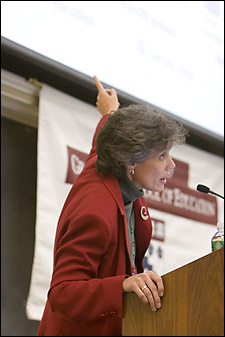What makes kids drop out of college?

Since the No Child Left Behind Act was signed by President Bush in January 2002, standardized testing, the re-taking of classes, and high drop-out rates have been in the news almost daily. But the April 25 Askwith Forum, chaired by Kennedy School of Government Lecturer in Public Policy Ronald Ferguson, addressed a question that has not been posed widely enough, in the estimation of many educators: Why do high school graduates become college dropouts, and what can we do about it?
Melissa Roderick, the evening’s main speaker, began the evening by discussing the high degree of aspiration common in today’s public schools. “If you go into any urban high school right now,” said the professor at the School of Social Service Administration at the University of Chicago and co-director of the Consortium on Chicago School Research, “and sit down with parents and kids and ask, ‘What do you want to get out of high school?’ there’s only one answer: ‘Graduate and go to college. Graduate and go to college. Graduate and go to college.’” Mirroring nationwide trends, she added, 80 percent of the public high school students in Chicago seek to attend a four-year college, and another 14 percent say they’d be happy with a two-year degree.
Unfortunately, the number of children actually attaining those goals falls sadly short. “Of the 80 percent of freshmen who walk into Chicago public schools and hope to complete a four-year degree,” Roderick continued, “we would expect that about 6.5 percent, unless something changes dramatically, will be able to attain that degree by their mid-20s.” Yes, that’s 6.5, not 65, percent – with dramatic gender and racial gaps between the few who will make it and the many who will not.
So how do educators, administrators, and policymakers go about making those dramatic changes Roderick and many others feel are required?
She had several suggestions. First, she said, the “epicenter” of the problem is the transition from grammar school to high school. Of students who are “on track” by the end of their freshman year of high school – that is, they have enough credits to continue and no failures in major subjects – 81 percent graduate four years later. Of those who are not on track, only 22 percent graduate. To get all students on track, Roderick contended, “there must be real structural and curricular reforms” as early as the ninth grade.
This pattern emerges as a significant one for the college transition. The “go to class, pass your courses” philosophy of most of today’s urban high school students is not giving them the strategies they need to get through college, Roderick emphasized. “Work on college means they’ll actually have to do something in high school between freshman and senior years.”
Bridget Terry Long, an associate professor of education and economics at the Graduate School of Education (HGSE), addressed the issue of what happens to those students who do well enough in high school to get into college – even if, perhaps, a nonselective college or community college – but are not prepared for the workload once they get there.
“There’s a huge and growing debate about remediation,” she said, but little in the way of hard research. The bottom line, however, is that “students in remediation have better outcomes. They’re more likely to persist, they’re more likely to graduate within six years, and they’re less likely to transfer down to a less selective college.” Nonetheless, only about a third of the students receiving remedial assistance are likely to graduate from college.
Both women advocated giving placement exams earlier, in the 10th or 11th grade, to provide students feedback regarding what high school courses they need to take to avoid remediation in college, as well as summer bridge programs that not only build students’ skills, but also increase their confidence by showing them what it’s like to be on the campus and helping them to network with people who will support them as they go through the next four years.
Finally, they discussed the college programs themselves. “I can focus on making sure the kids are prepared moving in,” said Roderick, “but I’ve also got to make sure that they are walking in to high-quality environments.”
Long called it a Catch-22: Students don’t do well, so appropriations are cut, which, by decreasing the number of permanent faculty members who are available to students during office hours and increasing class sizes, leads to even fewer students doing well.
Despite what Roderick repeatedly called the “abysmal” statistics, chair Ron Ferguson ended on a positive note. “There are reasons for hope nationally with regard to narrowing the achievement gap,” he said. “We cut more than two-thirds out of the reading score gap in the nation between 1970 and 1990, and about a third out of the math score gap over that period. The IQ gap between blacks and whites has narrowed by between a fifth and a third between 1972 and 2002. So there is progress being made on a number of fronts. The point is that when we deliver bad news, we deliver it with a sense of hope, and we just have to continue to promote that.”




